Seat Exeo 2010 User Guide
Manufacturer: SEAT, Model Year: 2010, Model line: Exeo, Model: Seat Exeo 2010Pages: 319, PDF Size: 9.64 MB
Page 11 of 319
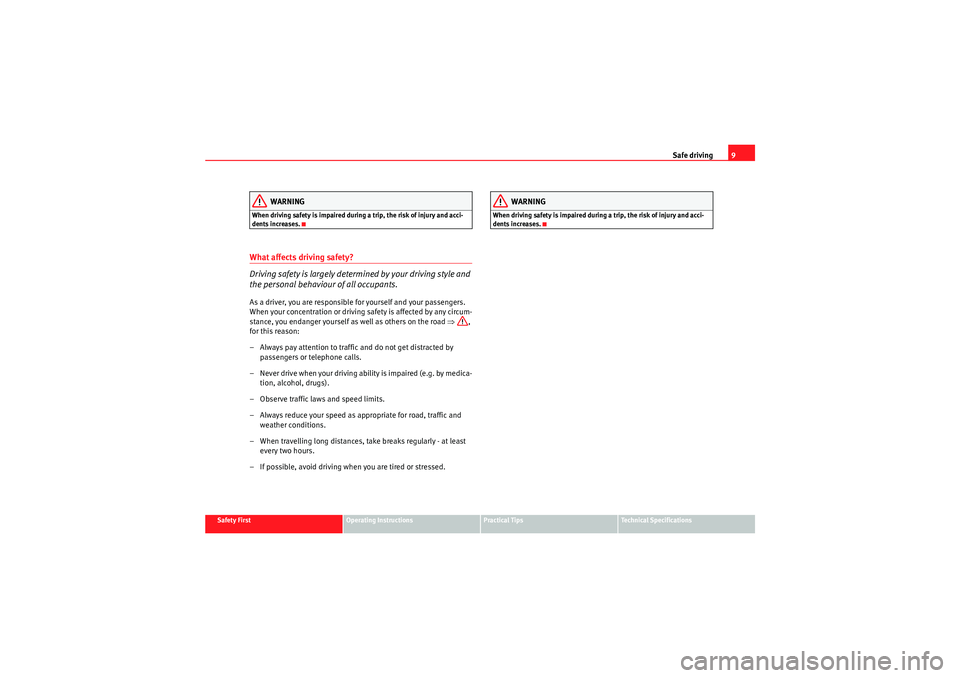
Safe driving9
Safety First
Operating Instructions
Practical Tips
Technical Specifications
WARNING
When driving safety is impaired during a trip, the risk of injury and acci-
dents increases.What affects driving safety?
Driving safety is largely determined by your driving style and
the personal behaviour of all occupants.As a driver, you are responsible for yourself and your passengers.
When your concentration or driving safety is affected by any circum-
stance, you endanger yourself as well as others on the road ⇒,
for this reason:
– Always pay attention to traffic and do not get distracted by passengers or telephone calls.
– Never drive when your driving abil ity is impaired (e.g. by medica-
tion, alcohol, drugs).
– Observe traffic laws and speed limits.
– Always reduce your speed as appropriate for road, traffic and weather conditions.
– When travelling long distances, take breaks regularly - at least every two hours.
– If possible, avoid driving when you are tired or stressed.
WARNING
When driving safety is impaired during a trip, the risk of injury and acci-
dents increases.
exeo_EN.book Seite 9 Montag, 30. August 2010 4:45 16
Page 12 of 319
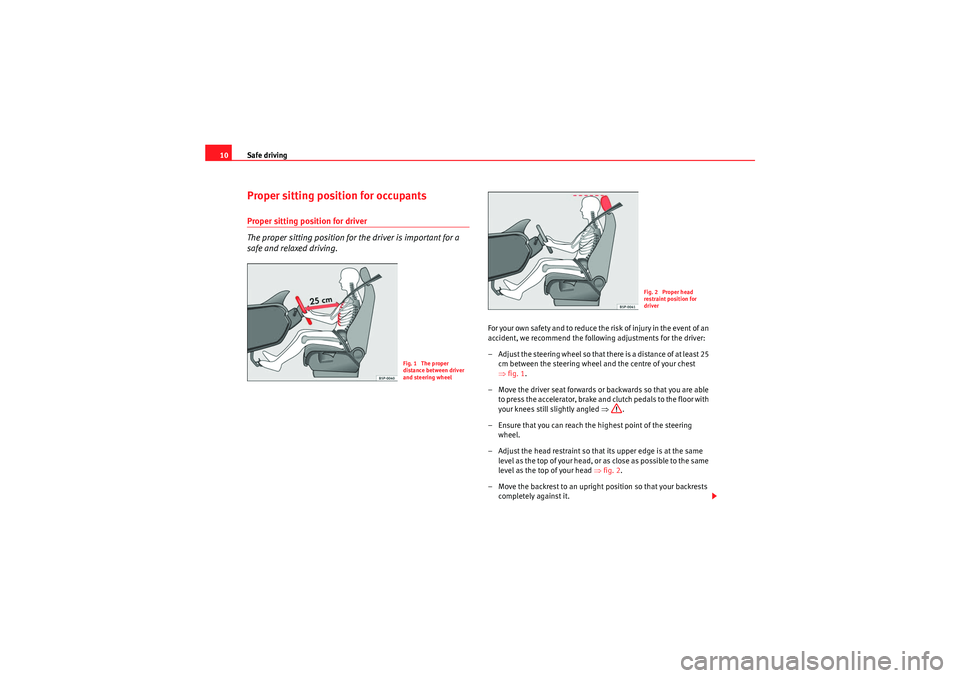
Safe driving
10Proper sitting position for occupantsProper sitting position for driver
The proper sitting position for the driver is important for a
safe and relaxed driving.
For your own safety and to reduce the risk of injury in the event of an
accident, we recommend the following adjustments for the driver:
– Adjust the steering wheel so that there is a distance of at least 25 cm between the steering wheel and the centre of your chest
⇒fig. 1 .
– Move the driver seat forwards or backwards so that you are able to press the accelerator, brake and clutch pedals to the floor with
your knees still slightly angled ⇒.
– Ensure that you can reach the highest point of the steering wheel.
– Adjust the head restraint so that its upper edge is at the same level as the top of your head, or as close as possible to the same
level as the top of your head ⇒fig. 2 .
– Move the backrest to an upright position so that your backrests completely against it.
Fig. 1 The proper
distance between driver
and steering wheel
Fig. 2 Proper head
restraint position for
driver
exeo_EN.book Seite 10 Montag, 30. August 2010 4:45 16
Page 13 of 319
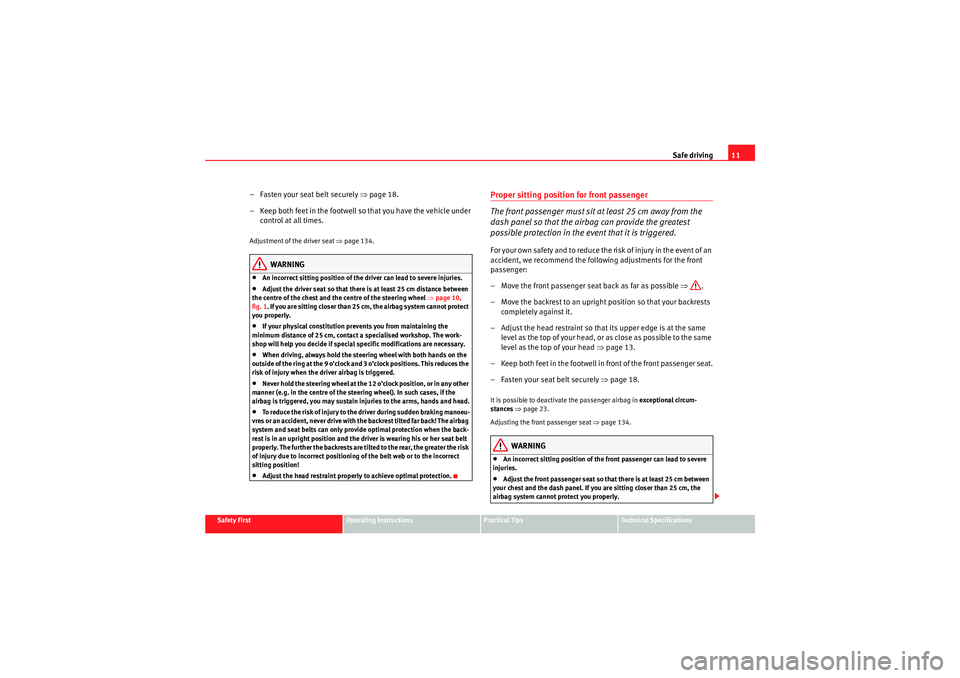
Safe driving11
Safety First
Operating Instructions
Practical Tips
Technical Specifications
– Fasten your seat belt securely ⇒page 18.
– Keep both feet in the footwell so that you have the vehicle under control at all times.Adjustment of the driver seat ⇒page 134.
WARNING
•An incorrect sitting position of the driver can lead to severe injuries.•Adjust the driver seat so that there is at least 25 cm distance between
the centre of the chest and the centre of the steering wheel ⇒page 10,
fig. 1 . If you are sitting closer than 25 cm, the airbag system cannot protect
you properly.•If your physical constitution prevents you from maintaining the
minimum distance of 25 cm, contact a specialised workshop. The work-
shop will help you decide if special specific modifications are necessary.•When driving, always hold the steering wheel with both hands on the
outside of the ring at the 9 o’clock and 3 o’clock positions. This reduces the
risk of injury when the driver airbag is triggered.•Never hold the steering wheel at the 12 o’clock position, or in any other
manner (e.g. in the centre of the steering wheel). In such cases, if the
airbag is triggered, you may sustain injuries to the arms, hands and head.•To reduce the risk of injury to the driver during sudden braking manoeu-
vres or an accident, never drive with the backrest tilted far back! The airbag
system and seat belts can only provide optimal protection when the back-
rest is in an upright position and the driver is wearing his or her seat belt
properly. The further the backrests are tilted to the rear, the greater the risk
of injury due to incorrect positioning of the belt web or to the incorrect
sitting position!•Adjust the head restraint properly to achieve optimal protection.
Proper sitting position for front passenger
The front passenger must sit at least 25 cm away from the
dash panel so that the airbag can provide the greatest
possible protection in the event that it is triggered.For your own safety and to reduce the risk of injury in the event of an
accident, we recommend the following adjustments for the front
passenger:
– Move the front passenger seat back as far as possible ⇒.
– Move the backrest to an upright position so that your backrests completely against it.
– Adjust the head restraint so that its upper edge is at the same level as the top of your head, or as close as possible to the same
level as the top of your head ⇒ page 13.
– Keep both feet in the footwell in front of the front passenger seat.
– Fasten your seat belt securely ⇒page 18.It is possible to deactivate the passenger airbag in exceptional circum-
stances ⇒ page 23.
Adjusting the front passenger seat ⇒page 134.
WARNING
•An incorrect sitting position of the front passenger can lead to severe
injuries.•Adjust the front passenger seat so that there is at least 25 cm between
your chest and the dash panel. If you are sitting closer than 25 cm, the
airbag system cannot protect you properly.
exeo_EN.book Seite 11 Montag, 30. August 2010 4:45 16
Page 14 of 319
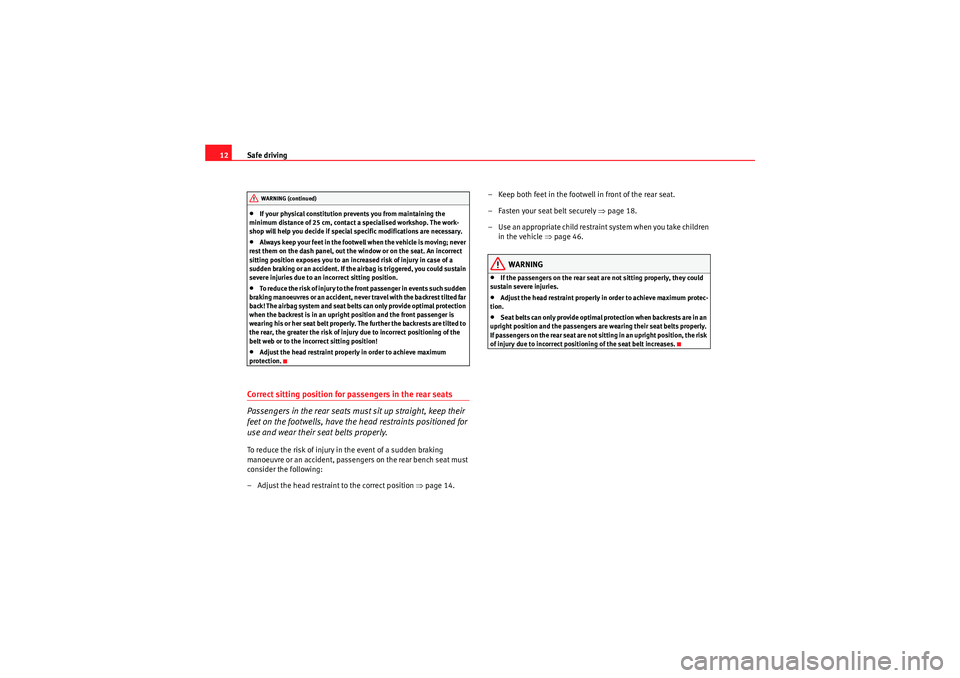
Safe driving
12•If your physical constitution pr events you from maintaining the
minimum distance of 25 cm, contact a specialised workshop. The work-
shop will help you decide if special specific modifications are necessary.•Al ways kee p you r feet in t he footw ell w hen t he vehicle is moving; never
rest them on the dash panel, out the window or on the seat. An incorrect
sitting position exposes you to an increased risk of injury in case of a
sudden braking or an accident. If the airbag is triggered, you could sustain
severe injuries due to an incorrect sitting position.•To reduce the risk of injury to the front passenger in events such sudden
braking manoeuvres or an accident, never travel with the backrest tilted far
back! The airbag system and seat belts can only provide optimal protection
when the backrest is in an upright position and the front passenger is
wearing his or her seat belt properly. The further the backrests are tilted to
the rear, the greater the risk of injury due to incorrect positioning of the
belt web or to the incorrect sitting position!•Adjust the head restraint properly in order to achieve maximum
protection.
Correct sitting position for passengers in the rear seats
Passengers in the rear seats must sit up straight, keep their
feet on the footwells, have the head restraints positioned for
use and wear their seat belts properly.To reduce the risk of injury in the event of a sudden braking
manoeuvre or an accident, passengers on the rear bench seat must
consider the following:
– Adjust the head restraint to the correct position ⇒page 14. – Keep both feet in the footwell in front of the rear seat.
–Fasten your seat belt securely
⇒page 18.
– Use an appropriate child restrain t system when you take children
in the vehicle ⇒page 46.
WARNING
•If the passengers on the rear seat are not sitting properly, they could
sustain severe injuries.•Adjust the head restraint properly in order to achieve maximum protec-
tion.•Seat belts can only provide optimal protection when backrests are in an
upright position and the passengers are wearing their seat belts properly.
If passengers on the rear seat are not sitting in an upright position, the risk
of injury due to incorrect positioning of the seat belt increases.
WARNING (continued)
exeo_EN.book Seite 12 Montag, 30. August 2010 4:45 16
Page 15 of 319
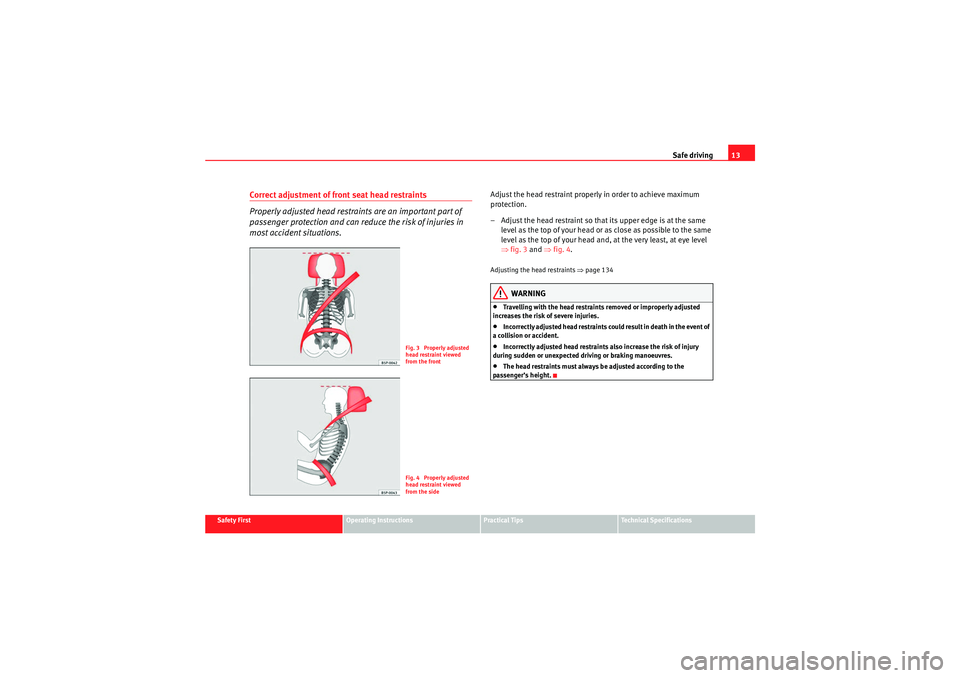
Safe driving13
Safety First
Operating Instructions
Practical Tips
Technical Specifications
Correct adjustment of front seat head restraints
Properly adjusted head restraints are an important part of
passenger protection and can reduce the risk of injuries in
most accident situations.
Adjust the head restraint properly in order to achieve maximum
protection.
– Adjust the head restraint so that its upper edge is at the same
level as the top of your head or as close as possible to the same
level as the top of your head and, at the very least, at eye level
⇒fig. 3 and ⇒fig. 4 .Adjusting the head restraints ⇒page 134
WARNING
•Travelling with the head restraints removed or improperly adjusted
increases the risk of severe injuries.•Incorrectly adjusted head restraints could result in death in the event of
a collision or accident.•Incorrectly adjusted head restraints also increase the risk of injury
during sudden or unexpected driving or braking manoeuvres.•The head restraints must always be adjusted according to the
passenger’s height.
Fig. 3 Properly adjusted
head restraint viewed
from the frontFig. 4 Properly adjusted
head restraint viewed
from the side
exeo_EN.book Seite 13 Montag, 30. August 2010 4:45 16
Page 16 of 319
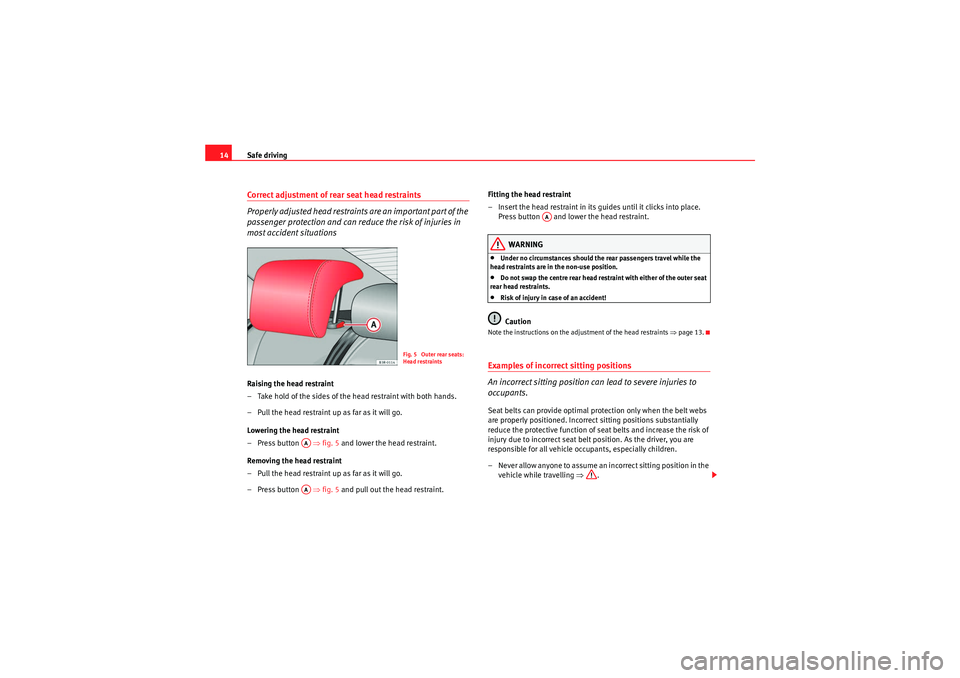
Safe driving
14Correct adjustment of rear seat head restraints
Properly adjusted head restraints are an important part of the
passenger protection and can reduce the risk of injuries in
most accident situationsRaising the head restraint
– Take hold of the sides of the head restraint with both hands.
– Pull the head restraint up as far as it will go.
Lowering the head restraint
–Press button ⇒fig. 5 and lower the head restraint.
Removing the head restraint
– Pull the head restraint up as far as it will go.
–Press button ⇒fig. 5 and pull out the head restraint. Fitting the head restraint
– Insert the head restraint in its guides until it clicks into place.
Press button and lower the head restraint.
WARNING
•Under no circumstances should the rear passengers travel while the
head restraints are in the non-use position.•Do not swap the centre rear head restraint with either of the outer seat
rear head restraints.•Risk of injury in case of an accident!Caution
Note the instructions on the adjustment of the head restraints ⇒page 13.Examples of incorrect sitting positions
An incorrect sitting position can lead to severe injuries to
occupants.Seat belts can provide optimal protection only when the belt webs
are properly positioned. Incorrect sitting positions substantially
reduce the protective function of se at belts and increase the risk of
injury due to incorrect seat belt position. As the driver, you are
responsible for all vehicle occupants, especially children.
– Never allow anyone to assume an incorrect sitting position in the vehicle while travelling ⇒.
Fig. 5 Outer rear seats:
Head restraints
AAAA
AA
exeo_EN.book Seite 14 Montag, 30. August 2010 4:45 16
Page 17 of 319
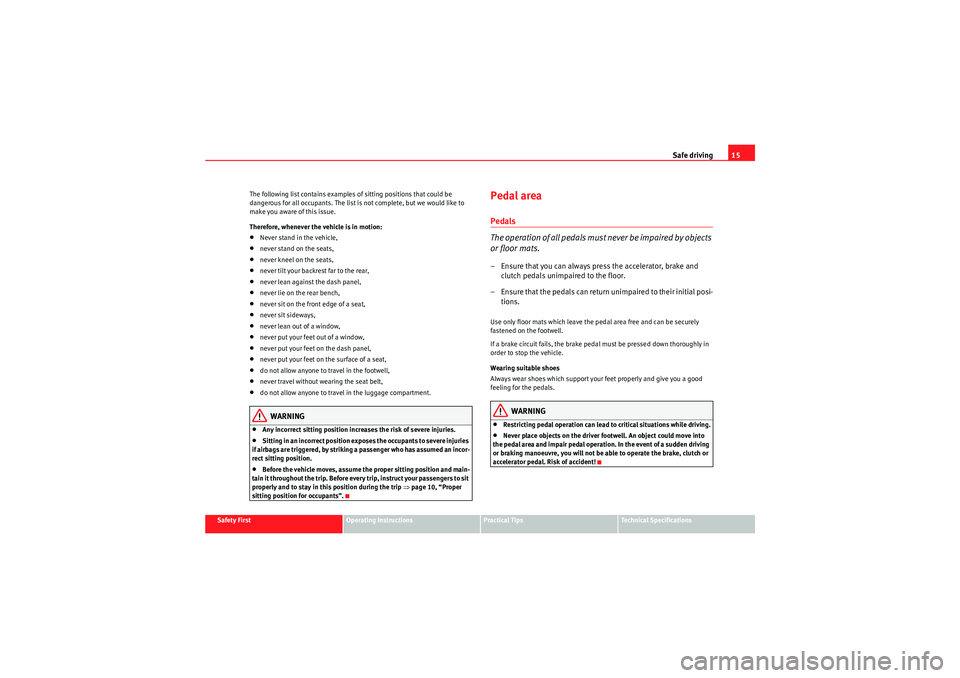
Safe driving15
Safety First
Operating Instructions
Practical Tips
Technical Specifications
The following list contains examples of sitting positions that could be
dangerous for all occupants. The list is not complete, but we would like to
make you aware of this issue.
Therefore, whenever the vehicle is in motion:
•Never stand in the vehicle,•never stand on the seats,•never kneel on the seats,•never tilt your backrest far to the rear,•never lean against the dash panel,•never lie on the rear bench,•never sit on the front edge of a seat,•never sit sideways,•never lean out of a window,•never put your feet out of a window,•never put your feet on the dash panel,•never put your feet on the surface of a seat,•do not allow anyone to travel in the footwell,•never travel without wearing the seat belt,•do not allow anyone to travel in the luggage compartment.WARNING
•Any incorrect sitting position increases the risk of severe injuries.•Sitting in an incorrect position exposes the occupants to severe injuries
if airbags are triggered, by striking a passenger who has assumed an incor-
rect sitting position.•Before the vehicle moves, assume the proper sitting position and main-
tain it throughout the trip. Before every trip, instruct your passengers to sit
properly and to stay in this position during the trip ⇒page 10, “Proper
sitting position for occupants”.
Pedal areaPedals
The operation of all pedals must never be impaired by objects
or floor mats.– Ensure that you can always press the accelerator, brake and clutch pedals unimpaired to the floor.
– Ensure that the pedals can return unimpaired to their initial posi- tions.Use only floor mats which leave the pedal area free and can be securely
fastened on the footwell.
If a brake circuit fails, the brake pedal must be pressed down thoroughly in
order to stop the vehicle.
Wearing suitable shoes
Always wear shoes which support your feet properly and give you a good
feeling for the pedals.
WARNING
•Restricting pedal operation can lead to critical situations while driving.•Never place objects on the driver footwell. An object could move into
the pedal area and impair pedal operation. In the event of a sudden driving
or braking manoeuvre, you will not be able to operate the brake, clutch or
accelerator pedal. Risk of accident!
exeo_EN.book Seite 15 Montag, 30. August 2010 4:45 16
Page 18 of 319
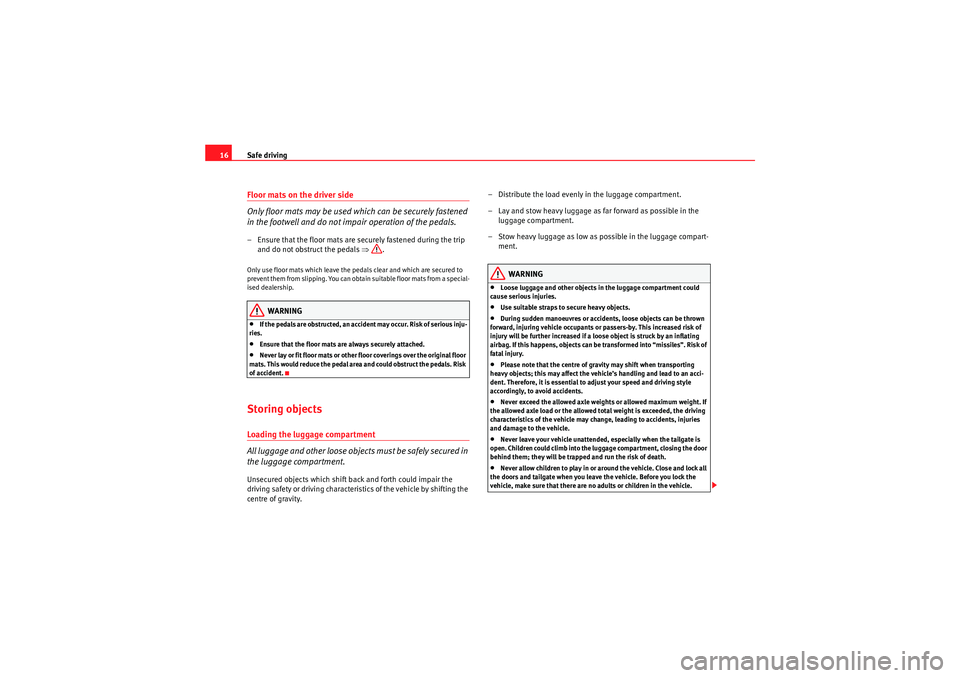
Safe driving
16Floor mats on the driver side
Only floor mats may be used which can be securely fastened
in the footwell and do not impair operation of the pedals.– Ensure that the floor mats are securely fastened during the trip
and do not obstruct the pedals ⇒.Only use floor mats which leave the pedals clear and which are secured to
prevent them from slipping. You can obtain suitable floor mats from a special-
ised dealership.
WARNING
•If the pedals are obstructed, an accident may occur. Risk of serious inju-
ries.•Ensure that the floor mats are always securely attached.•Never lay or fit floor mats or other floor coverings over the original floor
mats. This would reduce the pedal area and could obstruct the pedals. Risk
of accident.
Storing objectsLoading the luggage compartment
All luggage and other loose object s must be safely secured in
the luggage compartment.Unsecured objects which shift back and forth could impair the
driving safety or driving characteristics of the vehicle by shifting the
centre of gravity. – Distribute the load evenly in the luggage compartment.
– Lay and stow heavy luggage as far forward as possible in the
luggage compartment.
– Stow heavy luggage as low as possible in the luggage compart- ment.
WARNING
•Loose luggage and other objects in the luggage compartment could
cause serious injuries.•Use suitable straps to secure heavy objects.•During sudden manoeuvres or accidents, loose objects can be thrown
forward, injuring vehicle occupants or passers-by. This increased risk of
injury will be further increased if a loose object is struck by an inflating
airbag. If this happens, objects can be transformed into “missiles”. Risk of
fatal injury.•Please note that the centre of gravity may shift when transporting
heavy objects; this may affect the vehicle’s handling and lead to an acci-
dent. Therefore, it is essential to adjust your speed and driving style
accordingly, to avoid accidents.•Never exceed the allowed axle weights or allowed maximum weight. If
the allowed axle load or the allowed total weight is exceeded, the driving
characteristics of the vehicle may change, leading to accidents, injuries
and damage to the vehicle.•Never leave your vehicle unattended, especially when the tailgate is
open. Children could climb into the luggage compartment, closing the door
behind them; they will be trapped and run the risk of death.•Never allow children to play in or around the vehicle. Close and lock all
the doors and tailgate when you leave the vehicle. Before you lock the
vehicle, make sure that there are no adults or children in the vehicle.
exeo_EN.book Seite 16 Montag, 30. August 2010 4:45 16
Page 19 of 319
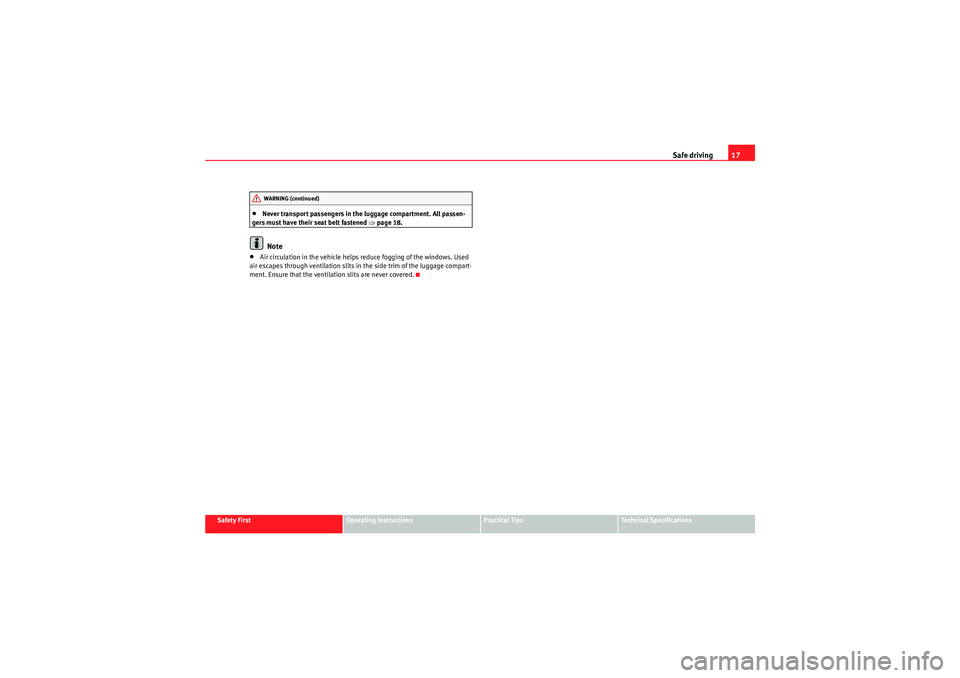
Safe driving17
Safety First
Operating Instructions
Practical Tips
Technical Specifications
•Never transport passengers in the luggage compartment. All passen-
gers must have their seat belt fastened ⇒page 18.Note
•Air circulation in the vehicle helps reduce fogging of the windows. Used
air escapes through ventilation slits in the side trim of the luggage compart-
ment. Ensure that the ventilation slits are never covered.WARNING (continued)
exeo_EN.book Seite 17 Montag, 30. August 2010 4:45 16
Page 20 of 319
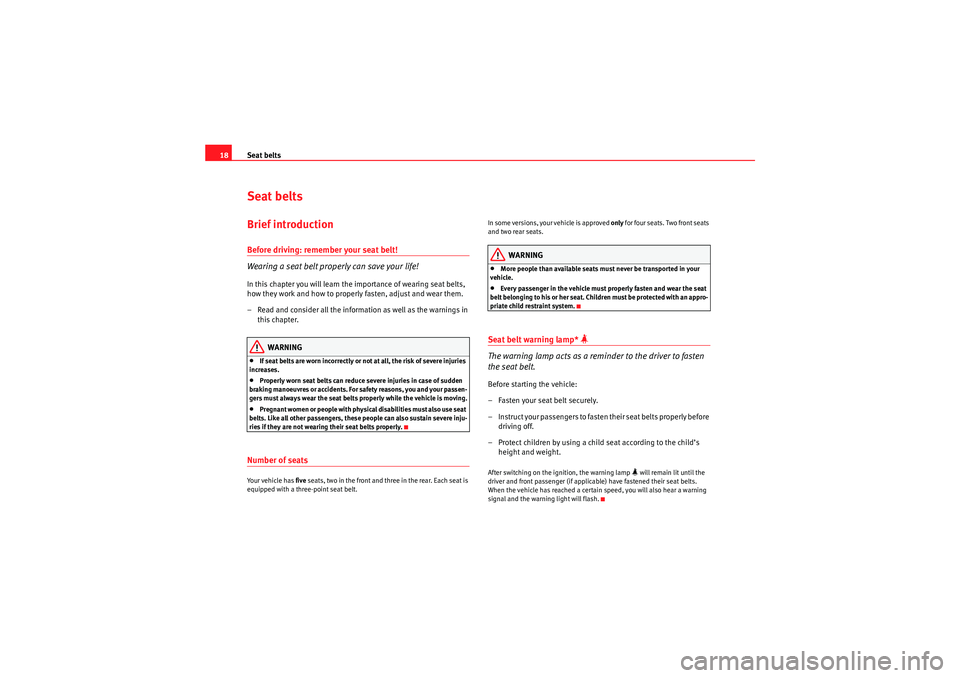
Seat belts
18Seat beltsBrief introductionBefore driving: remember your seat belt!
Wearing a seat belt properly can save your life!In this chapter you will learn the importance of wearing seat belts,
how they work and how to properly fasten, adjust and wear them.
– Read and consider all the informat ion as well as the warnings in
this chapter.
WARNING
•If seat belts are worn incorrectly or not at all, the risk of severe injuries
increases.•Properly worn seat belts can reduce severe injuries in case of sudden
braking manoeuvres or accidents. For safety reasons, you and your passen-
gers must always wear the seat belts properly while the vehicle is moving.•P r e g n a n t w o m e n o r p e o p l e w i t h p h y s i ca l d i s a b i l i t i e s m u s t a l s o u s e s e a t
belts. Like all other passengers, these people can also sustain severe inju-
ries if they are not wearing their seat belts properly.
Number of seatsYour vehicle has five seats, two in the front and three in the rear. Each seat is
equipped with a three-point seat belt. In some versions, your vehicle is approved
only for four seats. Two front seats
and two rear seats.
WARNING
•More people than available seats must never be transported in your
vehicle.•Every passenger in the vehicle must properly fasten and wear the seat
belt belonging to h is or her s eat . Child re n must be protecte d with an appro-
priate child restraint system.
Seat belt warning lamp*
The warning lamp acts as a reminder to the driver to fasten
the seat belt.Before starting the vehicle:
–Fasten your seat belt securely.
– Instruct your passengers to fasten their seat belts properly before driving off.
– Protect children by using a child seat according to the child’s height and weight.After switching on the ignition, the warning lamp
will remain lit until the
driver and front passenger (if applicable) have fastened their seat belts.
When the vehicle has reached a certain speed, you will also hear a warning
signal and the warning light will flash.
exeo_EN.book Seite 18 Montag, 30. August 2010 4:45 16